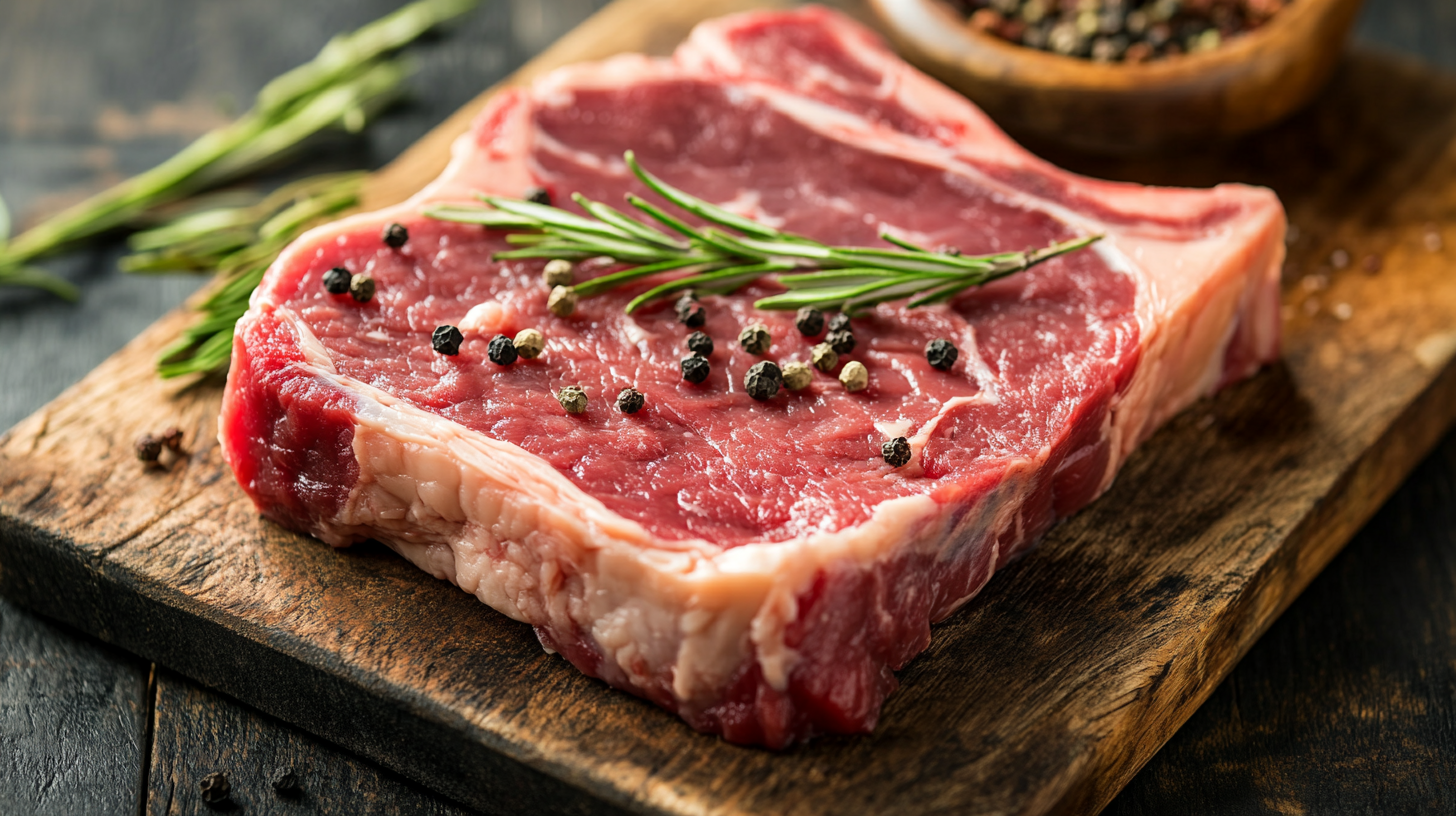10 Essential Tips for Sourcing High Quality Beef Processing Equipment Globally
In the ever-evolving landscape of the meat processing industry, sourcing high-quality beef processing equipment is crucial for optimizing production efficiency and ensuring product safety. As consumer demand for premium beef products continues to rise, processors are tasked with finding equipment that not only meets rigorous industry standards but also enhances operational capabilities. With a multitude of global suppliers to choose from, navigating this complex marketplace can be daunting for those new to the business or looking to upgrade their facilities.
This blog aims to provide essential tips for sourcing beef processing equipment effectively on a global scale. By focusing on key factors such as supplier reliability, equipment durability, and compliance with health regulations, we will help you make informed decisions that align with your processing needs and business goals. Whether you are a seasoned industry professional or a newcomer, these insights will empower you to invest wisely in the equipment that drives your success in the competitive beef processing sector.

Understanding Different Types of Beef Processing Equipment on the Market
In the rapidly evolving meat processing landscape, understanding the different types of beef processing equipment available in the market is essential for manufacturers looking to enhance efficiency and output. The global processed meat market is projected to reach a staggering $429.1 billion by 2029, with a compound annual growth rate (CAGR) of 5.0% from 2024. This growth is driven by increasing consumer demand for high-quality meat products, making it imperative for producers to invest in advanced processing solutions.
Various types of beef processing equipment cater to specific production needs, including meat grinders, slicers, and vacuum packaging machines. Each piece of equipment plays a vital role in ensuring the meat maintains its quality and safety throughout the processing stages. As the food processing and handling equipment market grows from an estimated $124.85 billion in 2025 to $183.06 billion by 2032, it is crucial for industry players to stay informed about innovative technologies and operational efficiencies.
Government initiatives, such as the USDA’s investment of nearly $110 million through the Meat and Poultry Processing Expansion Program, further highlight the importance of upgrading processing equipment to meet the rising demand for meat products. Producers must be aware of the types of machinery available and their functionalities, as efficient processing is critical to competing in a market where quality and sustainability are increasingly prioritized.
Distribution of Different Types of Beef Processing Equipment
Evaluating Supplier Credentials: What to Look For in Quality Assurance
When sourcing high-quality beef processing equipment globally, evaluating supplier credentials becomes paramount for businesses intent on optimizing their operations. One of the first aspects to scrutinize is the quality assurance certifications that a supplier holds. According to recent data, over 70% of supply chain management professionals emphasize the importance of verified credentials in their selection processes. Suppliers with recognized industry certifications not only demonstrate compliance with stringent standards but also reflect a commitment to quality, which significantly reduces the risks associated with procurement.
Furthermore, states play a pivotal role in supporting quality non-degree credentials, making it vital for businesses to consider suppliers accredited by reputable organizations. The findings from the Credential Lab initiative highlight that suppliers who participate in structured vetting processes improve their market credibility and increase their chances of establishing trustworthy partnerships. In industries where operational excellence is crucial, relying on suppliers with validated credentials can empower firms to guarantee not just machinery quality, but also assurance in service and support processes.
Additionally, as manufacturers increasingly emphasize skilled talent acquisition, evaluating the credentials of prospective suppliers can facilitate better hiring processes. Recent reports indicate that manufacturers leveraging industry credentials to vet candidates report a 40% improvement in talent acquisition efficiency. This trend underscores the interconnected nature of quality assurance measures and the overall performance of beef processing businesses, illustrating that robust credential evaluation is a cornerstone of successful global sourcing strategies.

Navigating Global Supply Chains: Tips for Efficient Equipment Sourcing
When it comes to sourcing high-quality beef processing equipment globally, understanding the intricacies of global supply chains is paramount. According to industry reports, the global meat processing equipment market is expected to reach $9.81 billion by 2026, growing at a Compound Annual Growth Rate (CAGR) of 5.3% from 2021 to 2026. This burgeoning market underscores the importance of efficient equipment sourcing strategies for businesses aiming to enhance their operations and output.
Navigating these global supply chains requires a clear understanding of key regions that excel in manufacturing beef processing equipment. Countries such as Germany, the United States, and Italy are known for their advanced technologies and strict quality controls, often resulting in superior products. Leveraging trade shows and industry expos, such as the International Meat Industry Show (IMEX), can provide invaluable opportunities to connect with manufacturers and understand the latest trends and innovations in equipment technology.
Moreover, awareness of local regulations and standards is crucial when sourcing equipment from different countries. For instance, the USDA regulations in the United States impose stringent requirements regarding food safety and equipment cleanliness. Ensuring compliance with such standards not only protects consumers but also helps in maintaining the integrity of your production processes. By strategically tapping into these global resources and adhering to regulations, businesses can effectively streamline their equipment sourcing endeavors and bolster their operational efficiency.
| Tip Number | Tip Description | Benefits | Considerations |
|---|---|---|---|
| 1 | Research Global Manufacturers | Identify top quality suppliers | Consider time zones and language barriers |
| 2 | Request Product Samples | Quality assurance prior to bulk order | Shipping costs for samples |
| 3 | Check Certifications and Standards | Assurance of industry compliance | Verification process may take time |
| 4 | Attend Industry Trade Shows | Networking and discovering suppliers | Travel costs and preparation needed |
| 5 | Evaluate Supplier Reliability | Long-term business sustainability | Depends on references and past performance |
| 6 | Understand Local Regulations | Ensure legal compliance in imports | Regulatory changes can be unpredictable |
| 7 | Negotiate Payment Terms | Manage cash flow effectively | Currency fluctuations can impact costs |
| 8 | Monitor Shipping Logistics | Ensure timely delivery of equipment | Potential delays due to customs |
| 9 | Plan for After-sales Support | Maintain equipment efficiently | Response time may vary |
| 10 | Establish Long-term Relationships | Better negotiation leverage and support | Trust-building takes time |
Comparing Costs: Balancing Quality and Affordability in Equipment Selection
When sourcing high-quality beef processing equipment, one of the most critical aspects to consider is the balance between cost and quality. While it might be tempting to opt for the most affordable options available, investing in higher-quality equipment can lead to significant savings in the long run. Higher-quality machines often have better durability and efficiency, which can reduce maintenance costs and downtime. Moreover, they tend to produce a superior product, enhancing overall customer satisfaction and retention.
Another important consideration is the geographical aspect of sourcing. Prices for beef processing equipment can vary significantly worldwide due to differences in manufacturing costs and import tariffs. An effective strategy involves researching and comparing prices from different regions while taking into account the quality of equipment. This can be facilitated by attending international trade shows or leveraging online platforms that specialize in industrial equipment. Engaging with suppliers from regions known for high-quality manufacturing can yield excellent results, ensuring that the equipment not only meets your budget criteria but also adheres to industry standards for safety and efficiency.
Ultimately, achieving the right balance between cost and quality is a multifaceted challenge that requires careful evaluation and strategic planning. By prioritizing equipment that offers the best long-term value rather than just the lowest price, businesses in the beef processing industry can enhance operational efficiency and ultimately boost profit margins.

Leveraging Technology: How Innovations Impact Beef Processing Equipment Choice
In the beef processing industry, leveraging technology has become crucial for sourcing high-quality processing equipment. Innovations such as automation, data analytics, and advanced safety features are no longer just trends; they are necessary for staying competitive in an increasingly demanding market. According to a report by Grand View Research, the global meat processing equipment market is expected to reach $16.7 billion by 2025, growing at a CAGR of 7.5%. This uptick underscores the shift towards more efficient processing technologies that enhance productivity and product quality.
One of the most significant technological advancements is the implementation of IoT (Internet of Things) solutions in processing plants. These tools enable real-time monitoring of equipment performance and product quality, which are essential for compliance with health and safety regulations. A study by the Food and Agriculture Organization (FAO) indicates that IoT can improve processing efficiency by up to 20%. This is particularly relevant when sourcing equipment globally, as it opens doors to innovative options that were previously unavailable in traditional suppliers.
Moreover, advancements in machinery technology—such as precision cutting and smart sorting solutions—improve yield and reduce waste. A report from Mordor Intelligence highlights that the adoption of high-tech equipment can lead to a 30% increase in operational efficiency. As producers seek to maximize profits while meeting consumer demands for higher quality beef, the integration of innovative processing equipment becomes not just beneficial but essential. These advances ensure that processors can maintain a competitive edge while improving sustainability within the industry.









